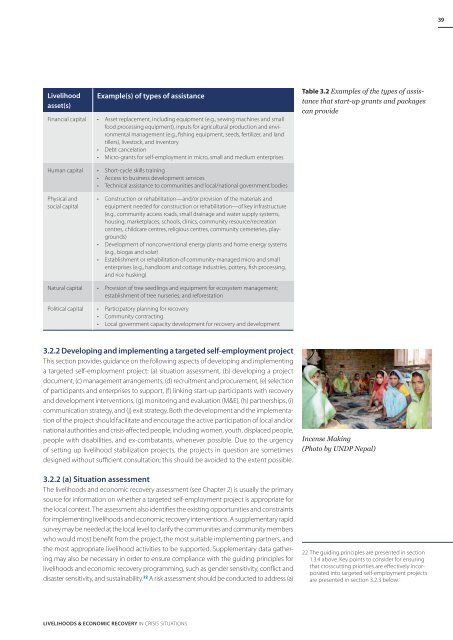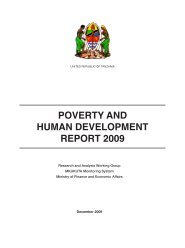Download PDF (4.08 MB) - ReliefWeb
Download PDF (4.08 MB) - ReliefWeb
Download PDF (4.08 MB) - ReliefWeb
Create successful ePaper yourself
Turn your PDF publications into a flip-book with our unique Google optimized e-Paper software.
39<br />
Livelihood<br />
asset(s)<br />
Example(s) of types of assistance<br />
Financial capital • Asset replacement, including equipment (e.g., sewing machines and small<br />
food processing equipment), inputs for agricultural production and environmental<br />
management (e.g., fishing equipment, seeds, fertilizer, and land<br />
tillers), livestock, and inventory<br />
• Debt cancelation<br />
• Micro-grants for self-employment in micro, small and medium enterprises<br />
Table 3.2 Examples of the types of assistance<br />
that start-up grants and packages<br />
can provide<br />
Human capital • Short-cycle skills training<br />
• Access to business development services<br />
• Technical assistance to communities and local/national government bodies<br />
Physical and<br />
social capital<br />
• Construction or rehabilitation—and/or provision of the materials and<br />
equipment needed for construction or rehabilitation—of key infrastructure<br />
(e.g., community access roads, small drainage and water supply systems,<br />
housing, marketplaces, schools, clinics, community resource/recreation<br />
centres, childcare centres, religious centres, community cemeteries, playgrounds)<br />
• Development of nonconventional energy plants and home energy systems<br />
(e.g., biogas and solar)<br />
• Establishment or rehabilitation of community-managed micro and small<br />
enterprises (e.g., handloom and cottage industries, pottery, fish processing,<br />
and rice husking)<br />
Natural capital • Provision of tree seedlings and equipment for ecosystem management;<br />
establishment of tree nurseries; and reforestation<br />
Political capital • Participatory planning for recovery<br />
• Community contracting<br />
• Local government capacity development for recovery and development<br />
3.2.2 Developing and implementing a targeted self-employment project<br />
This section provides guidance on the following aspects of developing and implementing<br />
a targeted self-employment project: (a) situation assessment, (b) developing a project<br />
document, (c) management arrangements, (d) recruitment and procurement, (e) selection<br />
of participants and enterprises to support, (f) linking start-up participants with recovery<br />
and development interventions, (g) monitoring and evaluation (M&E), (h) partnerships, (i)<br />
communication strategy, and (j) exit strategy. Both the development and the implementation<br />
of the project should facilitate and encourage the active participation of local and/or<br />
national authorities and crisis-affected people, including women, youth, displaced people,<br />
people with disabilities, and ex-combatants, whenever possible. Due to the urgency<br />
of setting up livelihood stabilization projects, the projects in question are sometimes<br />
designed without sufficient consultation; this should be avoided to the extent possible.<br />
3.2.2 (a) Situation assessment<br />
The livelihoods and economic recovery assessment (see Chapter 2) is usually the primary<br />
source for information on whether a targeted self-employment project is appropriate for<br />
the local context. The assessment also identifies the existing opportunities and constraints<br />
for implementing livelihoods and economic recovery interventions. A supplementary rapid<br />
survey may be needed at the local level to clarify the communities and community members<br />
who would most benefit from the project, the most suitable implementing partners, and<br />
the most appropriate livelihood activities to be supported. Supplementary data gathering<br />
may also be necessary in order to ensure compliance with the guiding principles for<br />
livelihoods and economic recovery programming, such as gender sensitivity, conflict and<br />
disaster sensitivity, and sustainability. 22 A risk assessment should be conducted to address (a)<br />
Incense Making<br />
(Photo by UNDP Nepal)<br />
22 The guiding principles are presented in section<br />
1.3.4 above. Key points to consider for ensuring<br />
that crosscutting priorities are effectively incorporated<br />
into targeted self-employment projects<br />
are presented in section 3.2.3 below.<br />
Livelihoods & Economic Recovery in Crisis Situations





